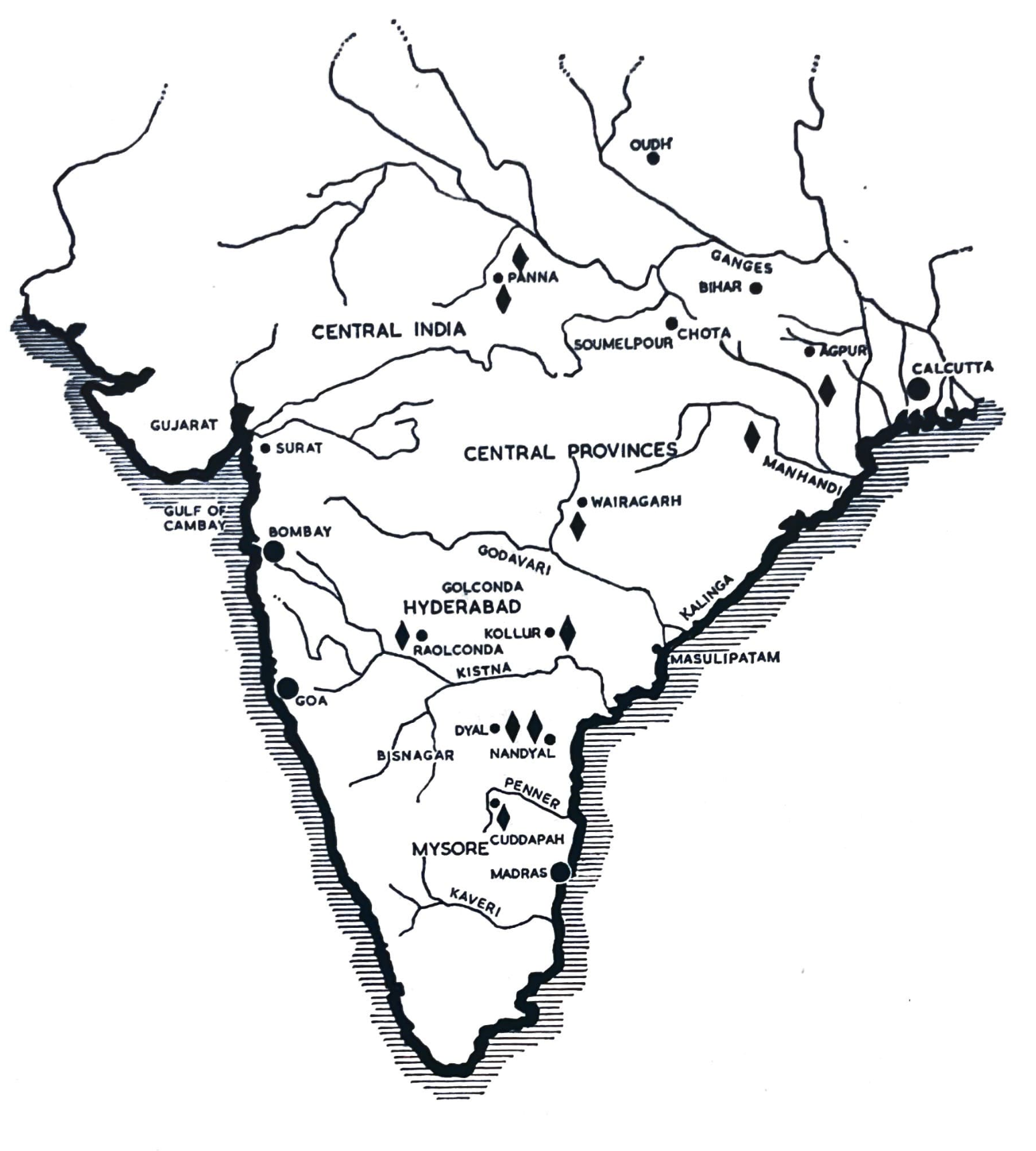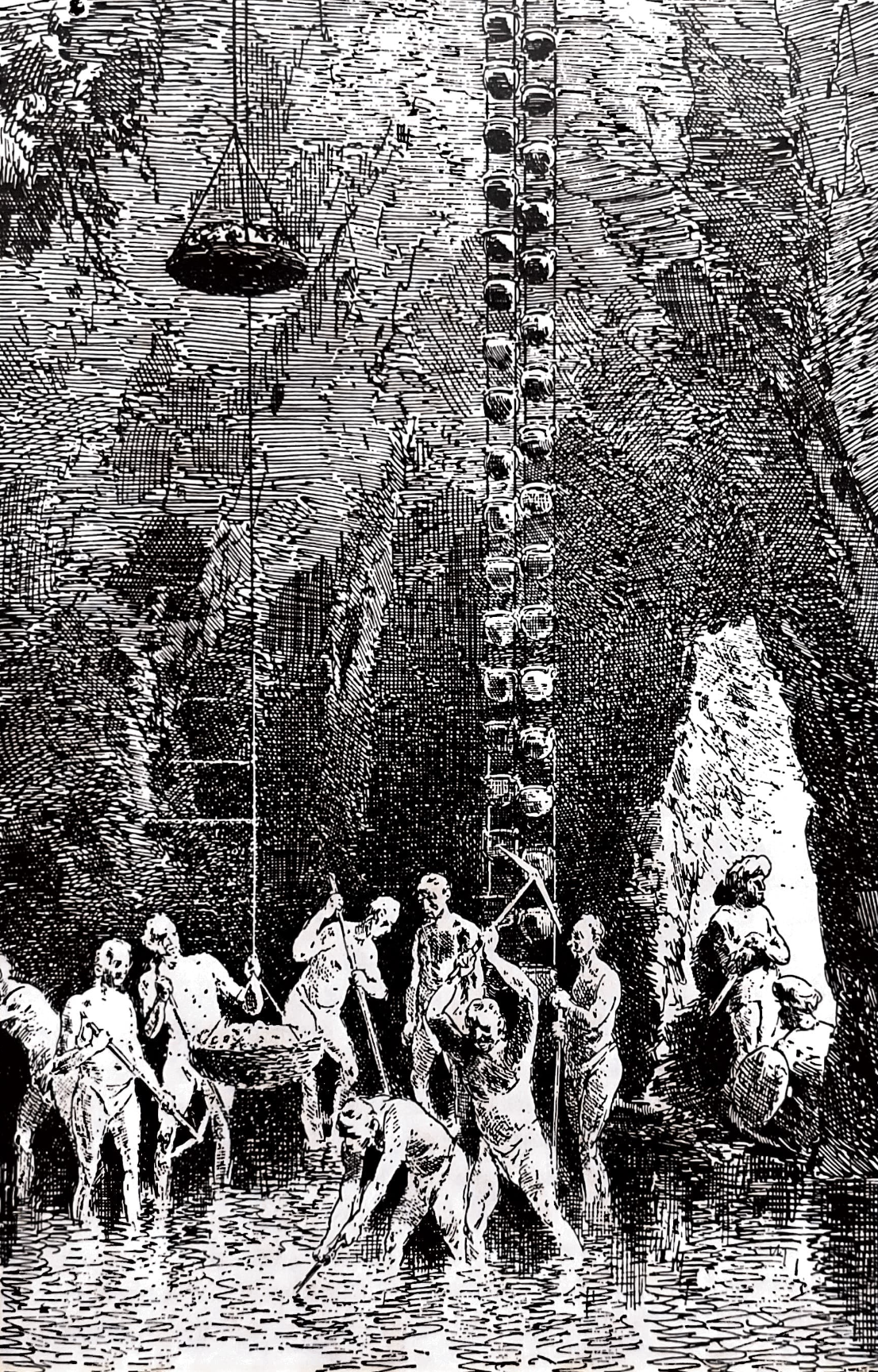Mining in India has been prominent since ancient times. Alluvial diamonds were known in India as early as about 800 B.C. The diamonds were found in compact sandstones and conglomerates and in the same materials after they had weathered, as well as in the sands and gravels of riverbeds and terraces. Indian diamonds were exported through the port of Alexandria at an early time and there is a reference in the writings of the Alexandrian astronomer Ptolemy to a diamond river in India. It is likely that diamonds were first found in India while mining for gold because the two minerals are found together in alluvial deposits. 
Tavernier visited a number of mines between 1630 and 1668, and most of our knowledge about them comes from his writings. The most famous works were at Kollur in the great gorge cut by the river Krishna in the south of the former kingdom of Golconda, now part of the State of Hyderabad. Kollur was where several historical diamonds, including the Koh-i-Nûr, the Regent, the Great Mogul, and the Tavernier Blue were found. Tavernier reported that there were 60,000 men, women and children at work at the diggings on the south bank of the river, which are said to have been discovered by the find of a 25 carat stone there about 1560.
Headquarters of the many diamond dealers were at the fortress town of Hyderabad to the north of the river workings. Diamonds from the scattered diggings were faceted if necessary at the village of Karwan outside the city Walls. The mines were divided into claims operated by local merchants who paid a levy to the local ruler plus a percentage of the value of stones discovered. The miners worked to a strict religious ritual. Having decided on the place to be worked, they levelled off an area beside it and surrounded this by a 2 ft (60 cm) wall, with holes or gates in it at intervals around the vase. The gates were blocked and earth and gravel from the mining area was dumped in the walled enclosure by women and children. When the mining area had been excavated, usually to a depth of about 14 ft (4.3m), water seepage prevented further mining.
The water was taken in pitchers and tipped into the walled area to bring the earth and gravel to a consistency of soup, which it reached after one or two Days. The gates were then opened to draw off the water and mud. Sometimes two or three washings were necessary until the hot sun dried off the remaining moisture and left only sand containing diamonds. The smaller material was winnowed like grain in baskets to allow the lighter elements to be blown away by the wind. The remainder was raked over, which exposed many lumps. The miners broke up the lumps by pounding the whole area with large wooden pestles or rams before winnowing once more. Finally the miners ranged themselves on one side and worked across the sand to pick out any diamonds by hand.
The best stones at Kollur, Tavernier reported, had a green crust on the surface, 'because when cut they proved to be white and of very beautiful water'. Nearly all the world's finest historical diamonds came from the Indian mines which were situated in an area of quite different geological formation from those in Africa and Siberia where most diamonds have been found subsequently. On the north bank downstream of the Krishna were more diggings called the Parteal that were worked until as late as 1850. Two mines were also exploited in the Golconda area from the 1960s.
West of Kollur were the Ramulkolta mines, worked in the nineteenth century, which are believed to have been the lost workings referred to by Tavernier as at Raolconda. Originally the miners dug deep pits in the sandstone and used iron rods, crooked at one end, to extract diamond-bearing gravels from veins in the rocks. To the south-east were more mines at Karnul, Nandyal and Wajrah Karur, which became famous later in Indian diamond mining history for the many large stones of around 60 carats found there. Diamonds were at one time found on the surface in a deposit washed out during the monsoons in a district known as Baraganpilly, after the name given to the diamondiferous stratum of gravel bound with stiff clay about 3 ft (1 m) thick and from about 3 ft to 16 ft (1-5m) deep under a sand and rubbed layer.
Diamonds from the deeper level were almost round because of long attrition in water. The most southerly mines were by the Penner or Pannar river in the Cuddapah district north of Madras, where the river cuts through the Eastern Ghats. The gravels here were of the Baraganpilly type. North of the Golconda area were alluvial workings at Wairagah on the banks of the river Wairagah in what became the Chanda district of Nagpur. They were called the Beiragahr mines by Tavernier. The diamonds occurred in a yellowish sandy soil. Other diamond deposits were found near rivers west of Calcutta.
The most northerly deposits were in the Panna area of the small state of Madhya by the Jumna and some tributaries of the Ganges river. The gravels are very thin and are from 192 to 26 ft (6-8 m) below the surface overlaid in some parts by clay, sandstone and laterite although there were areas where the diamondiferous deposit was on the surface. Near the town of Panna itself the old miners had to dig pits about 33 ft (10 m) deep and more than that across in the wet sandstone to extract diamonds.
